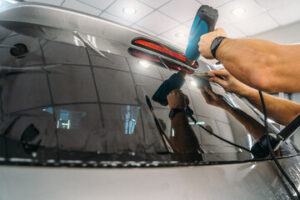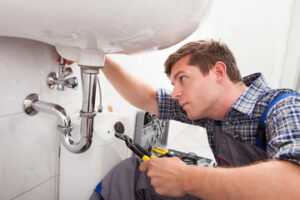Embarking on a sink drain replacement might seem like an intimidating DIY endeavor, but it’s quite manageable. Follow these steps to ensure smooth sailing from start to finish.
Begin by loosening all the connections with pipe wrenches or pliers. Avoid applying too much force to the connections, as excessive pressure can warp the pipes or create leaks. Contact Sink Drain Replacement Olmsted Falls now!

The sink drain is a benign home maintenance item. After all, it’s just a hole in the bottom of your sink. But outfitting that hole with the right drain accessories is a must if you want your sink to look its best and function. From a simple basket strainer to a more elaborate garbage disposal flange, there are many different options for you to consider.
Before starting any work on a sink replacement, take some time to choose a new drain that fits your needs. First, measure the diameter of the existing drain opening (the length of the threaded portion that goes through the sink and countertop) to make sure you’re ordering the correct drain size. You can also consult the instructions that came with your sink to get this information, or call a plumber for assistance.
Next, decide what type of piping material you want to use. Most household plumbing is either ABS or PVC, but if you’re replacing your old drain and you don’t mind a little extra work, you can also choose to use PEX. Ensure that whatever drain you purchase is compatible with the piping material you’re using, and follow any specific installation directions to avoid damage or failure.
Finally, consider the location of your new drain. The most common location is on the front edge of your sink, but some people prefer to move the drain to the back of the sink for a more aesthetically appealing look. There are pros and cons to both positions.
If you opt for a rear drain, be sure to consider how this will impact your kitchen workflow. It may not be possible to place large pots and pans under the sink without blocking the drain, for instance, and it might be difficult to access the plumbing for maintenance or repairs.
It’s important to remember that any sink drain installation must comply with local codes, and there may be restrictions on how far the drain can extend into the wall. For this reason, it’s usually best to hire a professional plumber for your sink drain replacement. They will be able to navigate these complexities and make sure your sink drain replacement harmonizes with your home’s plumbing infrastructure.
Disconnecting the Old Drain
A quick way to freshen up your bathroom is by replacing the sink drain. But before you can get started, you’ll need to disconnect the old P-trap and sink drain assembly. This can be tricky, but isn’t nearly as hard as it seems.
First, make sure the water is turned off. You’ll find shut-off valves behind the sink, which you should turn counterclockwise. Next, put a bucket or tray underneath the lowest part of the pipes to catch any water that flows out as you unscrew them. Be sure to clear away any hair and gunk that might spill out of the trap, as this is a common place for clogs to start.
The U-shaped pipe under your sink, known as the P-trap, holds water, forming a seal that prevents foul sewer gasses from traveling back up through your sink drain. It also helps trap small objects that might fall down the drain, protecting your home from plumbing disasters like backed-up sewer lines.
A straight section of pipe called the tailpiece mounts to the end of the P-trap. The drain stopper assembly’s lever rod connects to the tailpiece via a slip nut, which can be tightened and loosened by hand (or with gentle persuasion from channel-type pliers). The slip nut may be plastic or metal, depending on your sink’s plumbing.
It’s important to use the right kind of replacement parts for your sink’s pipes. If your pipes are PVC, make sure you buy a drain kit that’s PVC, and vice versa. The same goes for metal pipes, as mixing and matching can lead to leaks.
If your pipes are a mix of plastic and metal, consider removing the mixture to reveal the metal portions. This will give you a better idea of what your pipes are made of, which can help Boggs Inspection Services determine the best type of repair or replacement when the time comes. Then you can choose the appropriate parts from your local hardware store.
Removing the Old Drain
This is a fairly straightforward plumbing project, but you should always follow basic safety precautions when working with water. First, you’ll want to shut off your sink’s water supply. Look behind the sink for a valve, typically a small knob connected to your sink’s pipes and water lines, and turn it clockwise until you hear and see the water stop flowing. This step isn’t totally necessary if you only plan on replacing your sink drain, but it’s best practice to avoid any leaks or other issues that could pop up while you’re taking apart your sink’s pipe connections.
Next, you’ll need to remove the old drain. To do this, start by loosening the nut that holds your drain with a wrench. Once that’s done, you can then pull the drain out and away from its p-trap. Be sure to place a bucket underneath to catch any water or gunk that may flow out. Once you’ve removed the drain, take a pair of pliers and loosen the collars that hold the water supply lines attached to the trap. You should also use this opportunity to clean out any sediment that’s gathered in these connections.
Once you’ve loosened the p-trap’s collars, you can begin to remove it from the tailpiece of the drain. You’ll likely need to use the same pliers to dislodge any hair or other debris that’s stuck in there as well. Once you’ve gotten rid of the old drain, it’s time to start installing your new one.
Before you do this, though, make sure that your sink drain is compatible with the materials you’re using. Most modern homes use ABS or PVC, so you shouldn’t have any trouble finding a replacement that fits right in. You should also make sure that your new drain’s gasket is sealed properly to prevent any leaks. You can do this by using plumber’s putty or non-water-based silicone sealant, depending on what’s available and which kind you prefer. If you choose to use putty, be careful not to over tighten the nut that holds the drain in place or it might crack.
Installing the New Drain
Before installing the new drain, wipe away any old plumber’s putty remaining beneath the sink flange with a cloth or paper towel. You may have to loosen the lock nut underneath the flange of the drain with a pair of pliers. This can be a bit tricky because of the confined space under the sink. If you have trouble gripping the nut, try using the handles of a pair of pliers on opposite sides to steady the nut and get some leverage.
Then, assemble the new drain assembly by inserting the tailpiece of the P-trap into the hole in the sink and fitting the back of the p-trap into the waste pipe that leads into the wall. Connect the trap arm to the tee fitting on the drain tailpiece and tighten all slip nuts with channel-type pliers, but don’t overtighten.
Make sure the new drain fits well in the flange and that the washer rests flat over the drain’s flange. Also, make sure the drain is plumb (vertical and perpendicular to the sink). Then, gently but firmly, press the drain down against the flange of the p-trap to start the putty ring. Then, let the flange of the p-trap and the drain set for an hour or so.
It is a good idea to run water through the sink afterward to make sure everything from the drainage connection to the p-trap and drain line is working correctly. Debris or grime in the drains or traps can cause clogs that lead to major problems and costly repairs in other parts of the home.
Installing a garbage disposal in your sink can help you reduce the amount of food waste you throw away, and it can eliminate foul odors that build up in overflowing trash containers. You can find a wide variety of models that fit right into your existing drain, so you can pick the one that works best for your household and kitchen. Be sure to select a model that will fit in your plumbing system and match the color and finish of your other fixtures and appliances.








